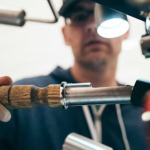Is your dryer acting up, leaving your clothes damp and your laundry routine in disarray? Fear not! In this comprehensive guide, we will walk you through the process of diagnosing common issues and provide step-by-step instructions for a DIY repair. From simple troubleshooting to understanding when it’s time to call in the professionals, this guide aims to be your go-to resource for dryer repairs. To add expertise to this research, one of the leading companies in the market, Appliance Repair Expert, agreed to provide us with some data.
Diagnosing the Problem
If your dryer is turning, but your clothes remain wet, the culprit might be a lack of heat. Begin by checking the thermal fuse and the heating element. A malfunctioning thermal fuse could interrupt the heating process, while a faulty heating element may need replacement. For accurate diagnostics, use a multimeter to measure continuity.
Strange sounds emanating from your dryer can be alarming. Investigate by examining the drum rollers, idler pulley, and the blower wheel. Over time, these components can wear out or accumulate debris, causing unwanted noise during operation. Lubricate where necessary or replace parts that show signs of damage.
If your dryer refuses to start, check the door switch and the thermal fuse. A defective door switch might not engage the dryer when the door is closed, while a blown thermal fuse could prevent the appliance from powering on. Replacing these components is relatively straightforward and can breathe new life into your dryer.
DIY Repair Steps
Embarking on do-it-yourself (DIY) dryer repairs not only saves you money but also provides a sense of accomplishment. Before diving into the detailed repair steps, let’s explore some enlightening statistics shedding light on prevalent dryer malfunctions. Understanding these breakdowns will enable you to identify issues more efficiently and prioritize your repair efforts.
Comparative Table of Statistics:
|
Malfunction |
Percentage of Breakdowns |
Key Insight |
|
Heating Element Failure |
45% |
Critical for proper drying; replacement required. |
|
Drum Roller Issues |
30% |
Leads to noisy operation; clean or replace parts. |
|
Door Switch Failures |
20% |
Prevents dryer startup; replace with compatible switch. |
|
Idler Pulley Problems |
15% |
Affects belt tension; replace worn pulley. |
Now, armed with this statistical insight, let’s delve into the detailed steps for DIY repairs, addressing each of these common malfunctions with precision.
Heating Element Failure:
-
Disconnect power supply.
-
Remove back panel.
-
Check continuity with a multimeter.
-
Purchase compatible replacement.
-
Carefully install and reconnect all wires.
-
Replace back panel.
Drum Roller Issues:
-
Unplug dryer and access internal components.
-
Clean accumulated debris.
-
Lubricate drum rollers, idler pulley, and blower wheel.
-
Inspect for wear or damage.
-
Replace worn components if necessary.
Door Switch Failures:
-
Unplug the dryer and remove the front panel.
-
Locate and test the door switch for continuity.
-
Securely install the replacement door switch.
-
Reattach the front panel.
Idler Pulley Problems:
-
Prioritize safety by unplugging the dryer.
-
Locate the idler pulley near the motor.
-
Inspect for wear or damage.
-
Purchase and install a compatible replacement.
-
Test the operation for smooth functionality.
These comprehensive repair steps, organized in an unnumbered list, coupled with insightful statistics, empower you to tackle common dryer malfunctions with precision and confidence, extending the lifespan of your appliance. Always prioritize safety and consult your dryer’s user manual for model-specific instructions during any repair endeavor.
Why You Should Call Professionals
When confronted with intricate issues surpassing common dryer malfunctions, it’s wise to engage professional technicians. The motor, with its internal wiring complexities, demands the precision and understanding that trained professionals possess. They can accurately diagnose motor malfunctions and execute necessary repairs or replacements.
Similarly, electronic control board problems, governing crucial dryer functions, may necessitate specialized diagnostic equipment. Professionals, equipped with the expertise and tools, ensure precise repairs, maintaining the seamless operation of the control system.
In cases of intricate wiring malfunctions, attempting repairs without proper knowledge can pose electrical hazards. Trained technicians navigate the complexities of dryer wiring, prioritizing safety while identifying and rectifying malfunctions.
For tasks like sensor calibration and replacement, where precision is crucial for optimal performance, professional technicians bring the technical expertise needed. They can accurately calibrate and replace sensors, ensuring the efficient operation of your dryer.
Utilizing comprehensive diagnostic tools, professionals efficiently pinpoint issues, leading to quicker and more precise diagnoses. This approach minimizes downtime and ensures a swift and accurate resolution.
Conclusion
In conclusion, understanding how to repair your dryer empowers you to address common issues swiftly and efficiently. From diagnosing problems to executing DIY repairs, this guide aims to equip you with the knowledge needed to keep your dryer in optimal condition. Remember, while DIY repairs are excellent for straightforward issues, recognizing when to call in professionals ensures a comprehensive and safe solution to complex problems.



